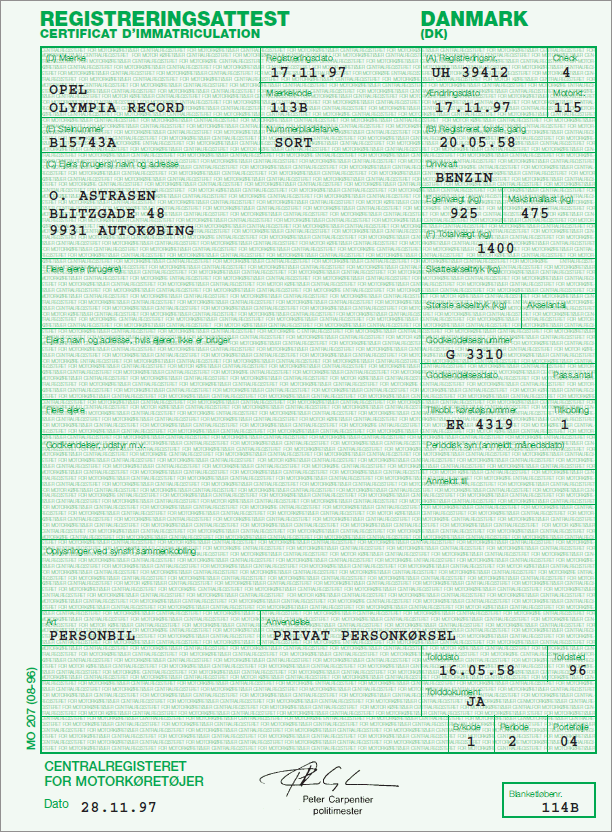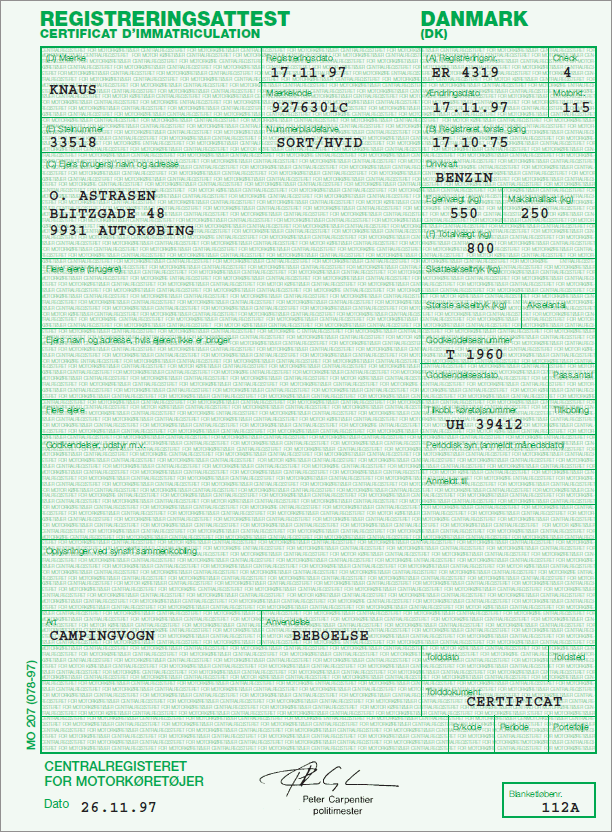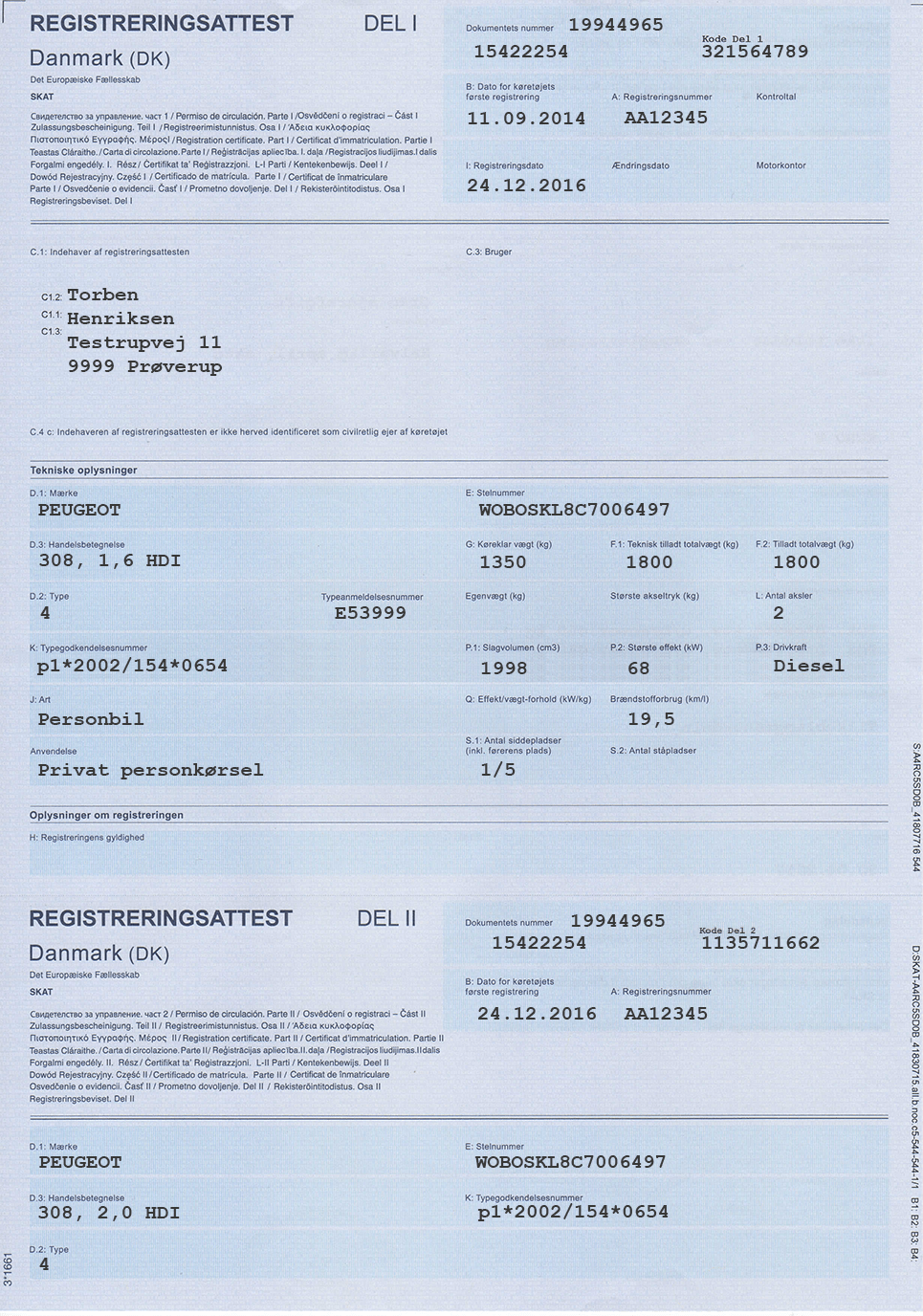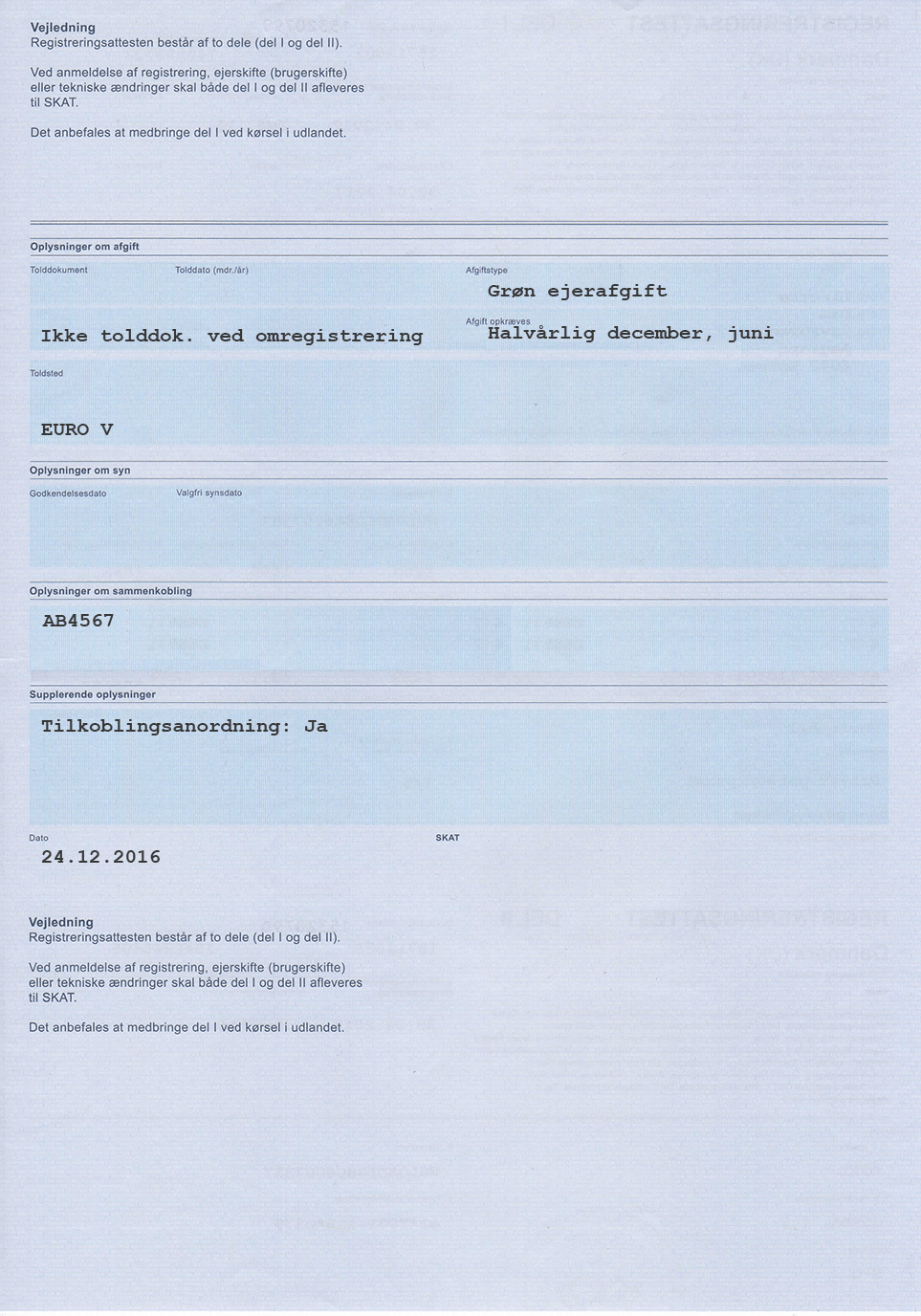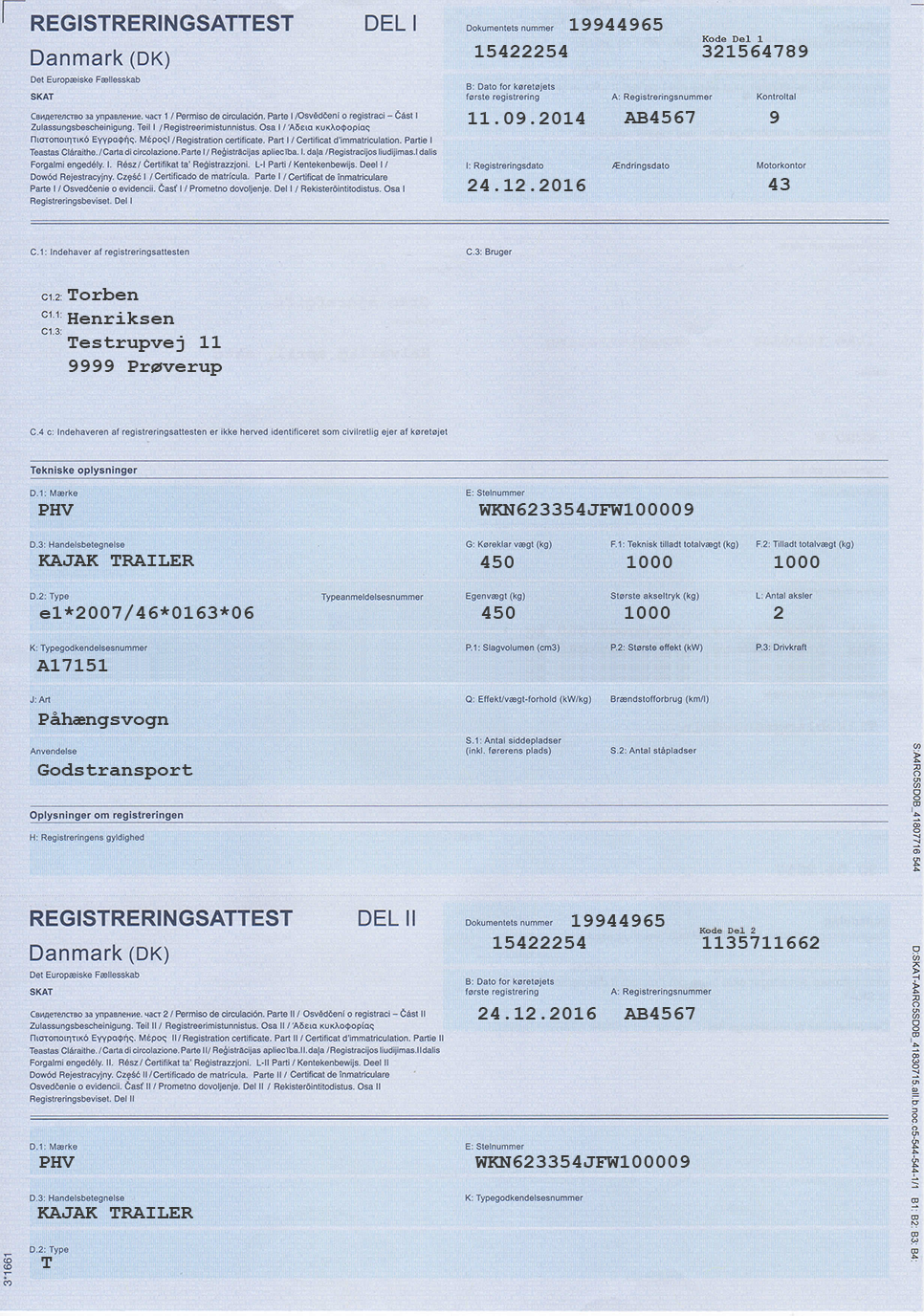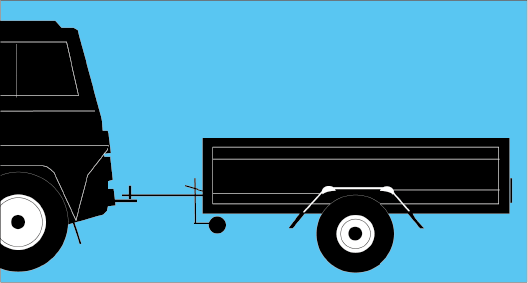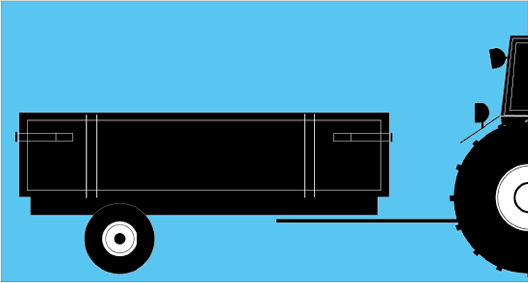Trailer
Driving school
theory book
for category B+ and BE
Section 1
Legal provisions on linking and documents.
Fixed combination means that a specific car is registered to tow a specific trailer. This may be because the coupling device is of a special type or due to other special circumstances. The trailer's registration number must then appear on the car's registration certificate and, conversely, the car's registration number on the trailer's registration certificate. You could say that the two vehicles can only drive with each other and not with anyone else.
Variable combination This means that the car is registered to tow several specific trailers, which must also be stated in the car's registration certificate. In addition, a coupling certificate is issued, which shows which trailers the car is authorised to couple with. The coupling certificate or a copy of it must be carried while driving. Prior to driving, the car and the vehicles in question must be inspected together at an MOT centre.
Sight-free pairing is the most common type of combination and means that a car and trailer can be coupled together without prior comprehensive inspection at an MOT centre. However, the car and trailer must be registered separately for sight-free coupling. Based on the registration certificates and by practical testing before driving, the driver must be able to determine whether the car and trailer match in terms of weight (including that the actual gross vehicle weight of the trailer does not exceed the maximum weight of the trailer stated on the car) as well as in terms of width and length. In order to be approved for sightless coupling, cars with a maximum authorised gross vehicle weight of up to 3500 kg must be equipped with a 50 mm coupling ball. Similarly, trailers up to 3500 kg gross vehicle weight must be equipped with a coupling part (ball cup).
The coupling device may also consist of a special coupling ("trailer hitch" or "NATO coupling").
Dokumenter.
When driving, you must always carry a copy or original of the vehicle and trailer registration certificates and, if applicable, the coupling certificate.
When travelling abroad, the original certificates or a copy (issued by SKAT) must be carried.
Fixed combination
Fast kombination er en meget sjældent benyttet registreringsform. Anvendes normalt kun på ældre biler med f.eks. 6 volt el system eller i de tilfælde, hvor påhængskøretøjet er udstyret med specielt bremsesystem (elektrisk eller hydraulisk overføring), eller måske en særlig tilkoblingsanordning.
De viste registreringsattester er af den gamle type, men findes stadig blandt ældre køretøjer og tilkoblings enheder.
Fixed combination
Registreringsattester til fast kombination. Fast kombination vil sige, at bilen er registeret til at trække et bestemt påhængskøretøj Påhængskøretøjets registreringsnummer skal da være anført på bilens registreringsattest. Her ser du de nye registreringsattester.
Definitions:
It is important that you learn as much as possible about the issues mentioned in this book in order to be able to meet the requirements for inspecting and controlling the trailer combination and to be able to control it during various manoeuvres. You must also master the skill of practising checking certain parts of the trailer's equipment and the parts of the vehicle that are related to the coupling, as well as being able to identify specific points where faults can occur. The test is therefore purely a test of practical skills. Below are some terms (definitions) that may be useful to know (these definitions are not included in the test).
Shaft pressure: The pressure transferred to the road from the wheels on an axle.
B+ driving licence: Provides a driving licence for combinations of vehicles with a maximum permissible total weight of 4250 kg, where the trailer exceeds 750 kg and the car's permissible total weight must not exceed 3500 kg.
B+E driving licence: Driving licence valid for a car with a maximum permissible total weight of 3500 kg coupled to a trailer with a maximum permissible total weight of 3500 kg, in total a combination of vehicles with a maximum weight of 7000 kg. B+ and B+E are often referred to as "trailer driving licences".
Double axle: Two axles on a vehicle that are positioned so close together that they effectively fulfil the same function as one axle. The advantages of a double axle on a trailer are better weight distribution and more stable steering and braking. Most trailers in the B+E context are double-axle.
Service brake: Braking system on a vehicle that operates "on the move" i.e. while driving, as opposed to a parking brake that brakes the vehicle while "parked" i.e. when it is stationary.
Tare weight: The weight of a vehicle with the accessories that the vehicle normally carries (such as a spare tyre). For the car, the weight of operating materials, fuel, lubricating oil, cooling water and driver are not included. For cars with a "New" type registration certificate, the weight is stated as the kerb weight. This is the factory weight of the car plus the weight of oil, water, fuel and driver (125 kg in total).
Trailer: A vehicle that is designed to be towed by another vehicle. Trailers are categorised as trailers, semi-trailers and towed implements.
Attachment tool: Is a trailer other than a trailer or semi-trailer that has a special function, e.g. a caravan or light shed trailer or similar.
Trailer: Is principally designed for the carriage of persons or goods, other than a semi-trailer.
Overrun brake: Service brake with a device that automatically applies the brake when the towing vehicle reduces speed.
Inscription: Sign or writing indicating specific weight limits.
Permitted loads: The difference between gross vehicle weight rating and kerb weight.
Permissible total weight: The maximum authorised weight of the vehicle with operating equipment, driver and load at the time of registration or approval (for trailers, normally only the load is included).
Tool coupling: Coupling type that is only used for driving with a "non-registrable" trailer such as a shed trailer or similar. Depending on the wheel tyres, the driving speed must not exceed 15/30 km/h. and an anti-detachment safety splitter must be used.
Actual gross vehicle weight: The instantaneous weight of the vehicle with operating equipment, driver and cargo.
Coupling certificate: Supplementary registration certificate. Certificate stating which specific trailers a particular car is authorised to tow. (Variable combination).
Clutch ball: Ball that is mounted on the towing vehicle and on which the coupling part of the trailer rests and is locked. Manufacturing dimensions: 50 mm. plus or minus 0.5 mm.
Combination: Is another term for coupling or two vehicles that are coupled together.
Ball coupling: The coupling part of the trailer, which is bolted to the drawbar of the trailer.
Sphere pressure: The pressure exerted by the trailer on the coupling ball. The trailer should be loaded in such a way that the ball pressure is approximately 5-10% of its actual gross vehicle weight.
Safety chain or safety wire: Same term for the chain or wire used between the car and trailer. The chain/wire must be used when the maximum authorised weight of the trailer is over 750 kg. and if this is over 1500 kg. it must be connected to the trailer's braking system in such a way that the trailer automatically brakes in the event of a breakage of the coupling device. (Also called "snap wire").
On single-axle trailers with a maximum authorised weight of no more than 1500 kg, you can instead have a chain/wire that, in the event of separation of the vehicles, prevents the towbar of the trailer from touching the ground and can maintain a certain amount of steering (the trailer remains "hanging" to the car).
Semi-trailer: Are principally designed for the transport of persons or goods and are coupled to the towing vehicle in such a way that the vehicle and its load rest partly on the towing vehicle.
Road trains: Car with an attached trailer.
